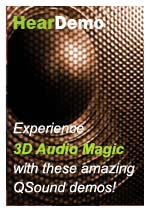About QSound Audio Technology
QSound Labs' full suite of three-dimensional (3D) audio algorithms extend the ability of a given number of audio output transducers (headphone elements or speakers) to convincingly position sound in arbitrary locations in space. Specific QSound Labs processes address the unique requirements of each situation according to:
- the number of input signals and the number of output channels
- nature of content: interactive vs passive
3D Positional Audio
Process Function
A basic 3D positional audio processor accepts a monophonic audio input signal, and produces two or more output signals as required to match the number and type (headphone, speaker) of output transducers in the playback system. The algorithm “positions” the sound for the listener at a specific apparent location. The specific signal manipulations and output distribution methods are necessarily specific to the output configuration.
Strictly speaking, simple stereo and multi-channel surround “panning” are themselves crude positioning algorithms. Simple panning uses only the relative level of the input signal sent to each output to provide a sense of direction, and has significant limitations. True 3D positional audio algorithms are an extension of this panning (panoramic) concept.
Applications
Because of the one-to-one mapping of input signal to specific spatial location, 3D positional audio has the following general areas of application:
- To create apparent or “virtual” speakers in place of physical ones, in order to render multi-channel surround content effectively with fewer physical speakers. (See Virtual Surround.)
- In the mixing phase of any multi-input audio production. Here a number of input signals, typically each representing an individual sound source (whether musical instrument, voice or sound effect) are positioned independently and mixed together to produce a music recording, TV or film soundtrack. This is referred to as pre-processing of passive content, since 3D is applied in the production environment and the end recipient simply sits passively to experience the prepackaged presentation with its built-in 3D audio effects.
- In a positioning and mixing application which has many similarities with “pro audio” production as described above: controlling multiple independent sounds for a virtual reality simulator or video game. Unlike the case of pre-processed passive content, this processing and mixing happens in real time on the end-user device, milliseconds before it is heard, according to the logic designed into the simulator or game engine, and dynamic user input. Hence this is classed as a real-time interactive application.
Presently, the most significant application for 3D positional audio is enabling of realistic audio environments for electronic gaming, whether in personal computers or handheld portable devices. QSound Labs addresses this market with its Q3D™ process.
Enhancement of Home Entertainment Audio
Mono & Stereo-to-3D
Stereo-to-3D enhancement, as provided by QSound Labs QXpander™, creates a more realistic and thus more enjoyable listening experience from existing source material by increasing the width, immersiveness—and thus realism—of the perceived audio image.
Stereo-to-3D has applications in computer and handheld audio as well as consumer entertainment electronics. Because enhancement can be applied to arbitrary source material (radio and television broadcast, recorded music, video, multi-media, games, etc.) and does not rely on special production techniques, it is suited to virtually any consumer audio product.
A special case of enhancement, mono-to-3D creates an ‘omnidirectional’ 3D stereo image. This is useful for improving mono recordings, broadcasts, or mono surround channels.
QXpander is available as a stand-alone algorithm, and as a feature of QHD, microQ, and mQFX.
Mono & Stereo-to-Surround
The completely unique QSound Multi-Speaker (QMSS™) algorithm creates 3, 4, 5, 5.1 or 7.1-channel output from plain mono or stereo input. Well suited to multi-channel PC audio systems, home theatre, compact surround systems and car audio, the QMSS process makes the input signal seem as though it were produced in multi-channel surround. Considering that most available content is still in mono or stereo formats, QMSS adds significant value to multi-speaker system.
Since QMSS can also be used to resynthesize multi-channel output from decoded and down-mixed surround content, it can serve as an economical alternative to the high licensing costs associated with full multi-channel decoding and output. If implemented using one of the company's analog integrated circuits, D/A cost reductions can also be realized.
Virtual Surround Sound
The goal of virtual surround sound (e.g. QSound Labs QSurround® process) is to render fully decoded multi-channel formats such as Dolby Digital effectively on headphones or using as few as two speakers. Multiple 3D audio processes are applied to the decoded surround channels in order to create virtual surround sound speakers (using positional 3D, or mono-to-3D, for stereo and mono surround signals respectively) and to improve the apparent separation of the front channels (stereo expansion). The individual processes outputs are then down- mixed, typically to two channels. Primary applications are home theater (See QSurround), desktop computers, and Mobile TV (See QSurround Mobile).
Surround Enhancement
Surround enhancement is akin to stereo enhancement in a multi-speaker setting. 3D can be usefully employed to “fill in” areas that are traditionally weak in the surround sound stage (especially the sonic gap that tends to exist between front and surround speakers) resulting in a more continuous and immersive experience. (See QSurround).

